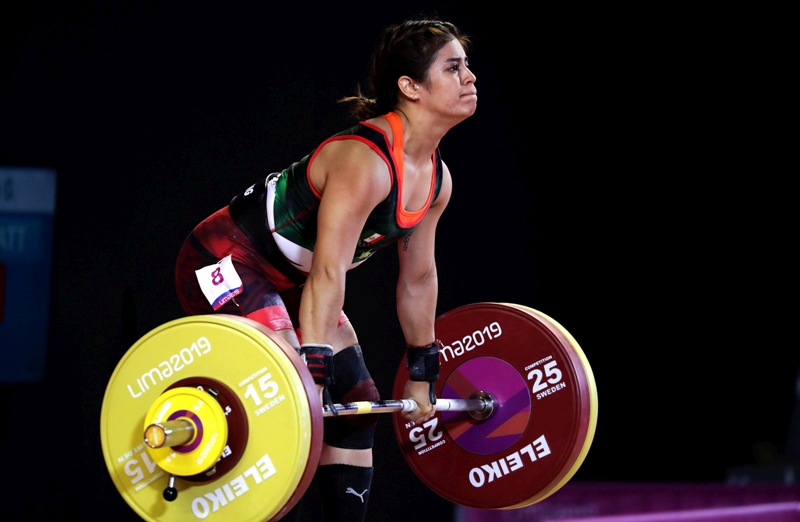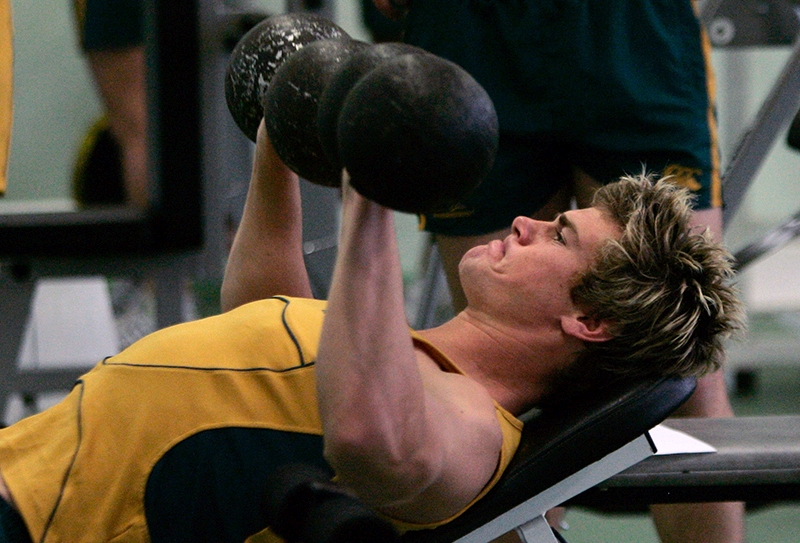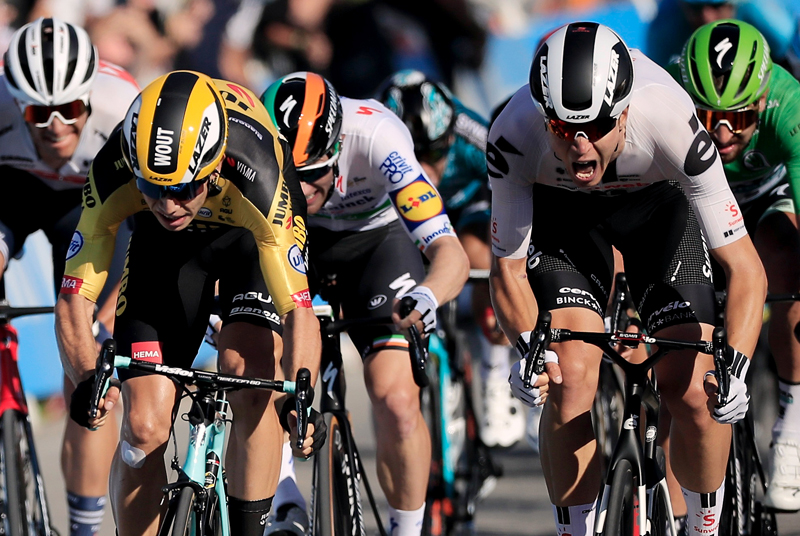You are viewing 1 of your 1 free articles. For unlimited access take a risk-free trial
Flywheel training: can it produce flying performance?
Sports Performance Bulletin looks at new research on the benefits of flywheel (isoinertial) resistance training and how athletes should execute it for maximum performance gains
Sports Performance Bulletin looks at new research on the benefits of flywheel (isoinertial) resistance training and how athletes should execute it for maximum performance gains
Although it may be unfamiliar to most athletes, a relatively new form of strength training known as ‘flywheel’ or ‘inertial’ training is attracting a lot of attention from researchers and gaining popularity among athletes seeking strength and performance gains. In a nutshell, flywheel training (also known as isoinertial or yoyo training) differs from conventional resistance training in that instead of lifting a weight against gravity, you accelerate or decelerate a flywheel (see image above which shows the Exxcentric Flywheel Training System).
Flywheel exercises were initially proposed in the early 1990s as a means to reduce the muscle atrophy in astronauts undergoing space travel for extended periods of time – an environment where the absence of gravity and muscle loading leads to rapid losses in muscle strength and mass. In the interim period, a number of scientific studies have described the theoretical and mechanical advantages of flywheel training, both for short and long-term training(1-3). The encouraging nature of this preliminary evidence has therefore prompted increasing interest among sport science researchers and coaches as a means to enhance athletic performance, reduce injury risk, and rehab injuries where they have occurred.
Biomechanical advantages of flywheel training
The potential advantage of flywheel training (see figure 1) is that the resistance is variable and unlimited, regardless of the direction or speed of motion. In particular, this allows excellent eccentric overload (ie muscle loading/resistance during the muscle lengthening phase of the movement) to be easily achieved – important because eccentric muscle exercise is particularly effective for building strength. Flywheel training is able to generate high eccentric loadings because of the inertia in the flywheel accumulated during the maximal-effort concentric phase(1). If you’ve ever spun up a large gyroscope and then tried to move it, you will understand this effect; once the inertia from the rotating mass is generated, changing/reversing its direction (in the case of flywheel training this entails moving from a concentric to eccentric contraction) requires a large amount of effort resulting in high muscle loading!
The reason why eccentric exercise is so effective is that during an eccentric movement, the applied external resistance can exceed the maximum momentary force produced by the muscle in a concentric muscle contraction – and with lower energy expenditure – resulting in greater work efficiency(4). Moreover, research has established that muscle protein synthesis (ie growth) can be further increased when both force generation and muscle and tendon stretching occurs concurrently, which are both involved during the eccentric contraction(5).
Yet another reason why athletes should be encouraged to incorporate strength training with an emphasis on eccentric muscle contractions is that this training mode is able to develop specific neural patterns of muscle activation – for example, requiring fewer motor units to generate the same amount of force during a submaximal exercise and enabling the muscle/tendon unit to contract with greater ‘kinetic efficiency’(6). This improved efficiency (also known as ‘muscle economy’) allows muscles to maintain a given sub-maximal workload with reduced oxygen consumption, thus reducing fatigue in athletes during endurance events. This is a very important factor in endurance performance; research clearly demonstrates that the key difference between world-class runners and those who are ‘merely elite’ is the exceptionally high muscle efficiency levels of the former(7) (see this article for a more detailed discussion on muscle economy and efficiency).
The evidence for flywheel training
There’s clearly plenty of theoretical rationale for the use of isoinertial training, but what about hard evidence for its benefits in the real world? Although this training mode is comparatively new, there’s already solid evidence that it is indeed effective for athletes. One study on swimmers evaluated the effects of four weeks of dry-land inertial training on muscle force, muscle power, and swimming performance(8). Fourteen national-level, competitive swimmers were randomly divided into two groups:
- *A control group – who simply continued with their pool training during the 4-week study period.
- *The inertial training group – who also continued their normal swim training, but also added in inertial training three times per week. This training was focussed on improving muscle strength required during the upsweep phase of the arm stroke in front crawl and butterfly stroke.
Before and after the 4-week training program, all the swimmers underwent testing for their 50m freestyle and 100m butterfly performance. In addition, the inertial-trained group underwent muscle-strength and electrical activity testing for the muscles they had trained with the inertial system.
The findings showed that after four weeks of training, the inertial-trained group recorded a 12.8% increase in their muscle force, and 14.2% increase in muscle power. The control group recorded no gains. Moreover, this translated into improved performance; compared to the control group, the inertial-trained swimmers also significantly improved their pool times, swimming 0.76% and 1.86% faster in the freestyle and butterfly tests respectively. Interestingly, the degree of improvement in each inertial-trained swimmer correlated closely to their strength and power gains.
Meanwhile, another study on inertial training the previous year found benefits for athletes recovering from injury(9). Just one weekly session emphasising eccentric overload was able to able to significantly boost lower-limb muscle power in athletes who had previously suffered patella tendon injury to the knee. Even better, these strength gains occurred without triggering any injury recurrence (something that is all too common with this type of injury).
More recently, a meta study (a study that pools data from a number of previous studies on the same topic) examined the effect of flywheel resistance training with an emphasis on eccentric overload on muscle size and functional capacities (ie strength and power) in athletes and healthy subjects(1). It also compared flywheel-induced adaptations with those obtained by traditional resistance exercise interventions and concluded: “Our analysis provides evidence supporting the superiority of eccentric-emphasized flywheel training, compared with traditional weight-stack exercise, to promote skeletal muscle adaptations in terms of strength, power and size in healthy subjects and athletes.”
Optimum flywheel training protocol
Overall, we can see that evidence to date suggests that inertial training is a very effective alternative to conventional weight training, and may even be superior in some aspects. However, being such a new training mode, what is less clear are the best training protocols for athletes to follow when flywheel training. In plain English, if you’re going to use flywheel training in your strength and conditioning program, what are the core principles you should stick to for best results?
Until recently, this was a largely unanswered question. But a very recently published study has surveyed all the different training protocols used in flywheel studies to try and determine which of these are likely to be beneficial in terms of producing maximum strength and functionality gains(10). Taking all the data into account, the researchers came up with the following recommendations:
*Training intensity - a range of inertial intensities ranging from 0.05 up to 0.29kg/m2) were recommended. When developing maximal force for sports-specific movements (eg vertical and horizontal jumps), higher intensities are preferred; lower intensities meanwhile seem to be preferable for developing power.
*Training volume – most studies have used between three and six sets per muscle group or movement, with each set utilizing 6-8 repetitions. However, some studies have found that short-term adaptations can be obtained with just 2-3 sets per muscle group.
*Training frequency and duration – the evidence here was less clear cut but the general consensus from the studies undertaken so far is that a flywheel training program consisting of two or three sessions per week over a period of 5–10 weeks is sufficient for inducing positive adaptive effects on strength and power. There’s also some evidence that the trained muscle groups begin to show measurable functional changes after just four weeks of training – for example when performing flywheel squats for a period of four weeks.
*Rest between sets – Following a set of flywheel exercises, athletes can expect to experience fatigue and a temporary drop in performance for up to three minutes, so there needs to be an adequate rest period between sets if multiple sets of the same numbers of reps are being performed. If the goal is post-activation potentiation enhancement (PAPE – see this article for more on PAPE), the subsequent activity should be performed between 3 and 9 minutes after the end of the flywheel work.
*Training specificity – Although studies have not focused on this aspect to date, the general principle of specificity is still likely to be relevant when flywheel training – ie greater gains in muscle functionality will be achieved if the pattern of movement executed during the flywheel training is as close as possible to that required in the sport the athlete is training for.
*Training familiarization – last but certainly not least is the importance of familiarization. For most athletes, flywheel training will be a completely new experience with very different movement executions and demands. Particularly important is the need to understand when and how to applying braking forces at the desired angles of the joints being used in order to obtain an eccentric overload. In the studies conducted to date, it was found that two or three carefully supervised sessions were needed for athletes to familiarize themselves and begin training independently.
In summary
An increasing body of research suggests that flywheel (isoinertial) training can deliver performance benefits to athletes that may exceed those obtain from conventional weight training. The reason for this is almost certainly down to the high degree of eccentric overload that flywheel training can induce in muscles. For those of you who are tempted to try flywheel training, it’s important to get some proper supervision in order to familiarize yourself on the techniques, and also follow the training protocol recommendations set out above!
References
- J Sci Med Sport. 2017 Oct; 20(10):943-951
- Front Physiol. 2017; 8():241
- J. Strength Cond. Res. 10.1519/JSC.0000000000003005
- Sports Med. 2017 Apr; 47(4):663-675
- J Strength Cond Res. 2018 Oct; 32(10):2750-2761
- Front Physiol. 2019; 10():536
- Appl Physiol Nutr Metab. 2006 Oct;31(5):530-40
- Eur J Sport Sci. 2017 May;17(4):369-37
- J Strength Cond Res. 2016 Jul;30(7):1834-42
- Front Physiol. 2020; 11: 569. Published online 2020 Jun 3
Newsletter Sign Up
Testimonials
Dr. Alexandra Fandetti-Robin, Back & Body Chiropractic
Elspeth Cowell MSCh DpodM SRCh HCPC reg
William Hunter, Nuffield Health
Newsletter Sign Up
Coaches Testimonials
Dr. Alexandra Fandetti-Robin, Back & Body Chiropractic
Elspeth Cowell MSCh DpodM SRCh HCPC reg
William Hunter, Nuffield Health
Keep up with latest sports science research and apply it to maximize performance
Today you have the chance to join a group of athletes, and sports coaches/trainers who all have something special in common...
They use the latest research to improve performance for themselves and their clients - both athletes and sports teams - with help from global specialists in the fields of sports science, sports medicine and sports psychology.
They do this by reading Sports Performance Bulletin, an easy-to-digest but serious-minded journal dedicated to high performance sports. SPB offers a wealth of information and insight into the latest research, in an easily-accessible and understood format, along with a wealth of practical recommendations.
*includes 3 coaching manuals
Get Inspired
All the latest techniques and approaches
Sports Performance Bulletin helps dedicated endurance athletes improve their performance. Sense-checking the latest sports science research, and sourcing evidence and case studies to support findings, Sports Performance Bulletin turns proven insights into easily digestible practical advice. Supporting athletes, coaches and professionals who wish to ensure their guidance and programmes are kept right up to date and based on credible science.












